Testing The World’s Best APUs: Desktop AMD Ryzen 4750G, 4650G and 4350G
by Dr. Ian Cutress on December 16, 2020 10:30 AM ESTCPU Benchmarks: Synthetic
All of our benchmark results can also be found in our benchmark engine, Bench.
Dwarf Fortress 0.44.12: Link
Emulating the ASCII interfaces of old, this title is a rather complex beast, which can generate environments subject to millennia of rule, famous faces, peasants, and key historical figures and events. The further you get into the game, depending on the size of the world, the slower it becomes as it has to simulate more famous people, more world events, and the natural way that humanoid creatures take over an environment. Like some kind of virus.
For our test we’re using DFMark. DFMark is a benchmark built by vorsgren on the Bay12Forums that gives two different modes built on DFHack: world generation and embark. These tests can be configured, but range anywhere from 3 minutes to several hours. After analyzing the test, we ended up going for three different world generation sizes:
- Small, a 65x65 world with 250 years, 10 civilizations and 4 megabeasts
- Medium, a 127x127 world with 550 years, 10 civilizations and 4 megabeasts
- Large, a 257x257 world with 550 years, 40 civilizations and 10 megabeasts
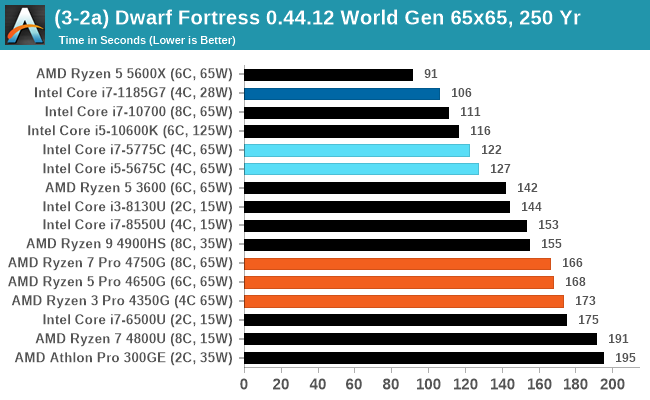
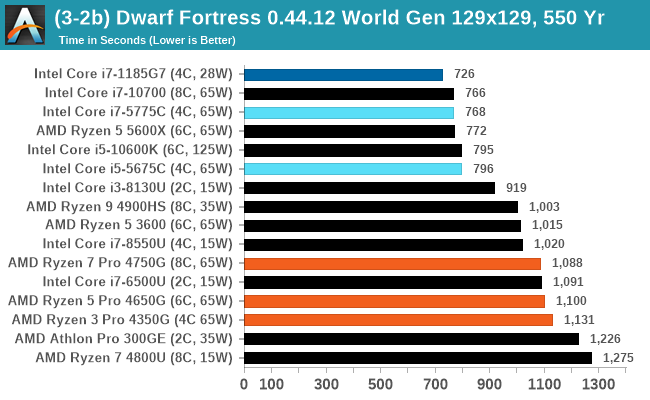
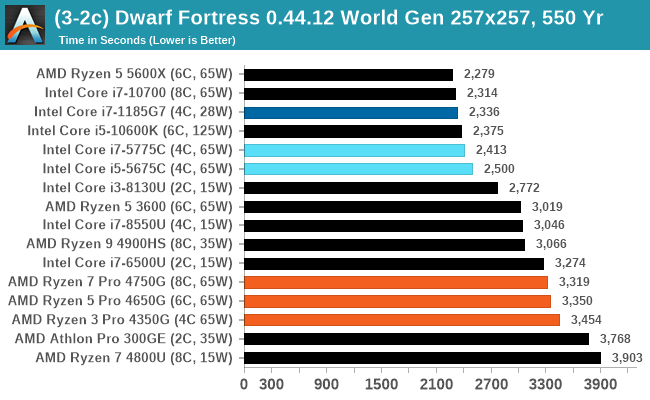
Dolphin v5.0 Emulation: Link
Many emulators are often bound by single thread CPU performance, and general reports tended to suggest that Haswell provided a significant boost to emulator performance. This benchmark runs a Wii program that ray traces a complex 3D scene inside the Dolphin Wii emulator. Performance on this benchmark is a good proxy of the speed of Dolphin CPU emulation, which is an intensive single core task using most aspects of a CPU. Results are given in seconds, where the Wii itself scores 1051 seconds.

3D Particle Movement v2.1: AVX2/AVX512
This is the latest version of this benchmark designed to simulate semi-optimized scientific algorithms taken directly from my doctorate thesis. This involves randomly moving particles in a 3D space using a set of algorithms that define random movement. For v2.1, we also have a fully optimized AVX2/AVX512 version, which uses intrinsics to get the best performance out of the software.
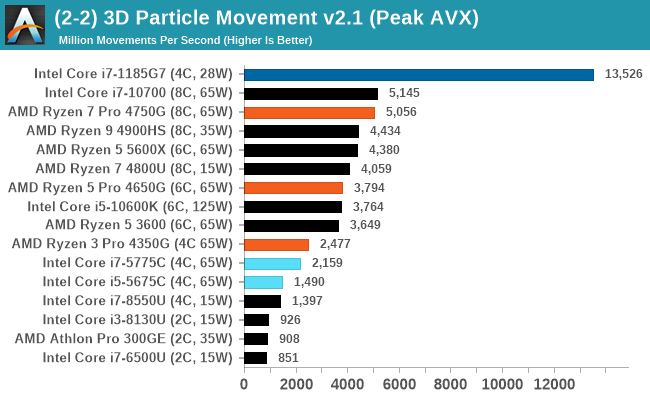
Tiger Lake wins here as it has an AVX512 unit.
y-Cruncher 0.78.9506: www.numberworld.org/y-cruncher
If you ask anyone what sort of computer holds the world record for calculating the most digits of pi, I can guarantee that a good portion of those answers might point to some colossus super computer built into a mountain by a super-villain. Fortunately nothing could be further from the truth – the computer with the record is a quad socket Ivy Bridge server with 300 TB of storage. The software that was run to get that was y-cruncher.
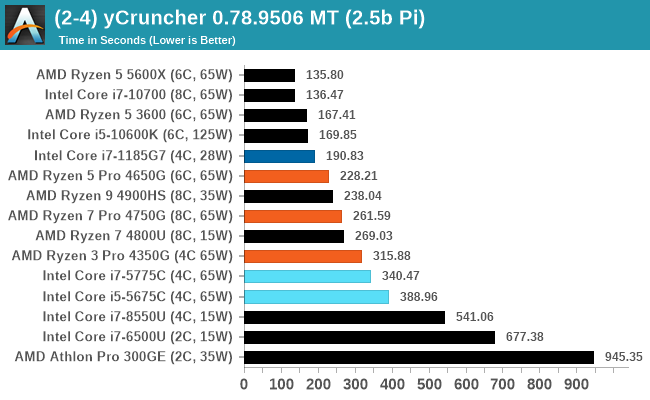
This is another AVX-512 test.
Linux OpenSSL Speed: SHA256
One of our readers reached out in early 2020 and stated that he was interested in looking at OpenSSL hashing rates in Linux. Luckily OpenSSL in Linux has a function called ‘speed’ that allows the user to determine how fast the system is for any given hashing algorithm, as well as signing and verifying messages.
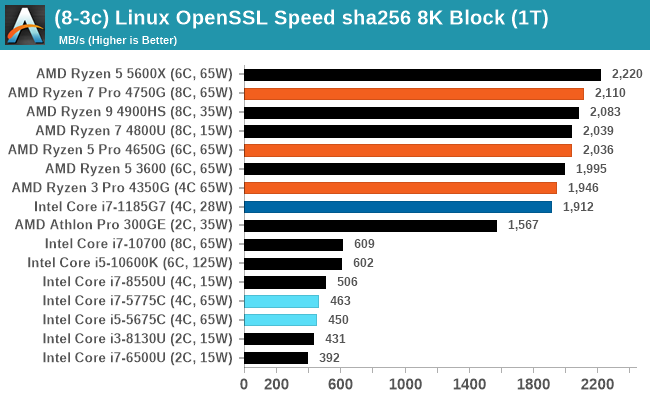
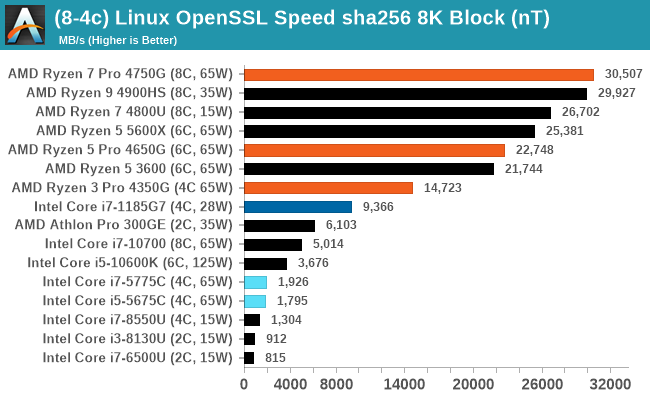










104 Comments
View All Comments
RSAUser - Wednesday, December 16, 2020 - link
Issues with this review:Missing 720p which is the most common gaming resolution for chips like these.
No check/attempt at any form of memory overclock/seeing if there's an easy one-click option and using it as a comparison point as well, since IGPU are all memory sensitive.
No frame time graph, average FPS is not even close to the whole story if there are frame drops, and at most of these averages I'd expect them to at times drop substantially.
Rudde - Wednesday, December 16, 2020 - link
If they'd overclock ram on one system, they'd have to do it on all systems. They are currently testing them at manufacturer clocks for the cpu, ram and gpu. Overclocking deserves its own article, but I'm afraid it'd require too much time to do with every processor in #CpuOverloadlinuxgeex - Wednesday, December 16, 2020 - link
It's about revealing the performance characteristics of the APU when either the CPU is the bottleneck (low resolution) or when the GPU is the bottleneck (high resolution) and then compare those limitations to the field so you can see how these APUs perform at those extremes. It's not about "let's see if we can squeeze a playable game out of this".TelstarTOS - Wednesday, December 16, 2020 - link
Average CPUs and bad APUs. Anything that performs worse than a 1650 is useless for gaming.foxalopex - Wednesday, December 16, 2020 - link
I actually recently picked up a Ryzen 5 Pro 3400GE from the aliexpress market. For a 35 watt chip with ECC support and built in GPU it makes an absolutely awesome little Linux server. I'm planning on adding a discrete GPU using PCI Passthrough to make up for graphics performance.zamroni - Wednesday, December 16, 2020 - link
Desktop doesn't need on die integrated gpu.Intel kabylake g design, which has Radeon die in cpu package, is actually better for desktop
schujj07 - Wednesday, December 16, 2020 - link
I do wonder how much of the Tiger Lakes advantages in the iGPU tests that it wins deals more with having 33% more RAM bandwidth.cbm80 - Wednesday, December 16, 2020 - link
"This means that the only company taking socketed desktop graphics seriously right now is AMD..."This is a strange statement given that AMD's integrated graphics offerings are a generation behind non-integrated, and the ones you can actually buy are two generations behind and have limited motherboard support.
Leeea - Wednesday, December 16, 2020 - link
I see Anandtech is continuing the moronic policy of using JEDEC memory speeds.At least enable XMP!
xMetaRidley - Thursday, December 17, 2020 - link
Seriously, that is incredibly stupid. Anyone running jedec has UNKNOWINGLY misconfigured their system. Why is a tech review site afraid to go into the BIOS and set the ram speed properly. It probably fell back to 2133mhz with ridiculous timings. Considering that Zen is sensitive to memory latency it makes the entire review worse than worthless.It would be like benchmarking a router's WAN performance by hooking it up to a 1.5mbps DSL modem then saying "we feel this benchmark is appropriate because much of the rural US is limited to this speed"